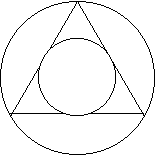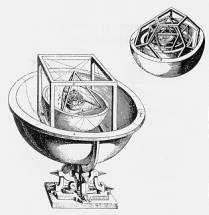 |
Harmony:
Mistakes and Miracles in
Johannes Kepler’s Cosmology
Don Thompson
Associate Dean of Seaver College
Pepperdine University
24255 Pacific Coast Highway
Malibu, CA 90263
The simplest theory is best. Ideal theory describes and predicts while confirming and resonating, and in so doing shows only the least effort, elegantly capturing imagination in brevity. But, such a holy grail of knowledge is also a tower of Babel. As explorers climb peaks to anchor their territorial flags, the shale eludes the spike; the snow blinds the eye. She who thinks SHE has “found it” has usually only glimpsed a dim reflection of otherwise hidden mysteries. As soon as theories are secured, the Heisenberg effect kicks in and they escape - like so much captured starlight. Such has been the plight of cosmology, a theoretical body attracting ongoing debate and counterpoint. While contemporary discourse celebrates the nature of Mars[1] and inquiries into the (in)finitude of the cosmos[2], and as minds such as Stephen Hawking and Roger Penrose posit their latest wrinkles in universal theories of everything, it is apropos to look back at similar such processes in humbler times, by examining Johannes Kepler’s cosmologies, micro and macro. Imagination and discovery, stimulated by controversy, competition, and creativity; confirmed by reason, theory, and experience – these are the ingredients of Kepler’s knowledge journey. Kepler shows us how his own epiphanic error produces genius in his attempts to formulate a functional description of the solar system.
Kepler’s first cosmological model was dead wrong. The inspiration came during a lecture on astronomy the Lutheran school of Graz[3]. The inspiration was drawn from triangle-circle-triangle inscription, circumscription as depicted in Figure 1.

Figure 1
Here, thought Kepler, is the first glimpse of a planetary cosmology of our solar system. As he gazed at the two circles, it occurred to him that the ratios of their radii matched the radii of the orbits of Saturn and Jupiter. (Kepler still held to circular planetary orbits.) As he attempted to expand this process to incorporate other planets, it became obvious that a three dimensional model of orbital relationship was needed. The next step was easy: there are six planets and thus five pairs of successive planetary ratios. These five ratios must be in harmony with the creator of the universe. Thus, the harmony deserves a perfect spatial home, and such a home may be found in the only five perfect three-dimensional objects, namely the Platonic solids: the tetrahedron, cube, octahedron, dodecahedron, and icosahedron, depicted, respectively, in Figure 2. These regular three dimensional geometric objects alone possess the property that each vertex is incident with the same number of edges and each face is a regular polygon.

Figure 2
Thus, Kepler theorized that the orbits of Mercury, Venus, Earth, Mars, Jupiter, and Saturn are harmonized by a system of spheres inscribed within and circumscribed without by the five Platonic solids. See Figure 3[4].

Figure 3
With this theory, known as the Mysterium Cosmographicum[5], Kepler imagined that a perfect harmonic system could incorporate all six of the planetary bodies (Neptune, Uranus, and Pluto were not known during Kepler’s lifetime) with their orbits guided by a geometry that was perfected by Euclid in ancient Greece. Furthermore, the dimensions of successive orbits obeyed proportions matching those of the musical scale intervals. His theory was integrative perfection, harmonizing Euclidean geometry and Pythagorean music with the orbits of the Copernican solar system. He writes “Wherefore it is clear that the very ratios of the planetary intervals from the sun have not been taken from the regular solids alone. For the Creator, who is the very source of geometry and, as Plato wrote, ‘practices eternal geometry,’ does not stray from his own archetype.”[6] Thus, God, the eternal geometer must have given us the Platonic solids on behalf of the planetary orbit structure. They were made for each other.
It was only when Kepler was later able to acquire accurate orbital data from Danish astronomer Tycho Brahe that his cosmological theory came under fire. Brahe’s data forced Kepler to reconcile his model’s prediction of the orbit of Mars, leading him to reject that portion of the model and subsequently the entire “harmonies of the world” system. Mysterium Cosmographicum was, at best, a cosmic dream, contradicting documented scientific data. God, if not subtle, did not play the same tune, nor was he quite so Platonic.
If Kepler had only left us this cosmology, his work would have been rejected, forgotten. However, via the process of examining and verifying his theory in conjunction with experimental data, he was led to greater work. For it was through Kepler’s re-examination of his Mysterium that he formulated the well known planetary laws of motion, laws that have been repeatedly verified and applied. These laws state that 1) planets orbit the sun in elliptical paths with the sun standing at one of the foci of the ellipse,
2) orbits sweep out equal areas in equal times as generated by a line joining the planet to the sun, and 3) the square of a planet’s orbit period is proportional to the cube of its mean distance from the sun[7]. In this case Kepler’s wrong gave birth to a right, largely because of his insatiable desire that the theory be precise, accurate, and commensurate with available data. It is difficult to continue to believe in a theory that remains in contradiction to mathematical precision. Fortunately, Kepler integrated his theory with data, in the best spirit of scientific inquiry.
Remarkably, the works of Copernicus, Kepler, and Galileo provide us with a single, harmonious, and functional heliocentric cosmology. However, much more than a simple cosmology has emerged from their joint efforts. The greatest praise of Kepler’s work may be found in the abundance of ongoing applications of his planetary laws. Perhaps the most interesting and timely application of Kepler’s work in this century is due to science fiction author Arthur C. Clarke. Clarke’s prophetic thinking makes him the father of satellite communication. In a paper published in 1945, he proposed placement of geo-synchronous satellites for worldwide radio coverage, an idea that is currently the basis of such technologies as cellular telephones and satellite television. In an article that was decades before its time, he wrote: “It will be observed that one orbit, with a radius of 42,000 km, has the period of 24 hours. A body in such an orbit, if its plane coincided with that of the earth’s equator, would revolve with the earth and would thus be stationary above the same spot on the planet. It would remain fixed in the sky of a whole hemisphere and unlike all other heavenly bodies would neither rise nor set.”[8]
Clarke capitalized on Kepler’s first and third planetary laws wherein a satellite orbits the earth with an orbital radius that can be predetermined so that the orbit period is twenty-four hours, thus creating a geo-synchronous heavenly body. Clarke’s work is contemporary evidence of the power of Kepler’s theoretical simplicity and elegance. Ellipses are simple enough geometric constructs to capture powerful cosmology.
Any attempt at scientific moralizing of Kepler’s theoretical journey leads us to conclude that scientific knowledge is hardly absolute or inert. It is continually both created and discovered – a living dyad which for creation relies on epiphany, accident, and inspiration; whereas for discovery it relies on “what ifs”, trial and error, contradiction, and tyrannical precision. Scientific knowledge therefore is a living, breathing, perhaps even social process which requires the tandem poles of creativity and discovery in order to perpetuate and auto-correct. Both creativity and discovery must continually spark and prod the imagination, but only if the scientific ego makes itself continually vulnerable to needed attack of its theoretical geography. Johannes Kepler demonstrated both creativity and discovery, kept in balance and corrected by precision and contradiction, giving us some reassurance that scientific knowledge is dynamic and controversial, to its own credit.
[1] Leonard David, “A Master Plan for Mars”, Sky & Telescope, April 1999, pp. 34-41.
[2] Jean-Pierre Luminet, Glenn D. Starkman, and Jeffrey R. Weeks, “Endless Space (maybe not)”, Scientific American, April 1999, pp. 90-97.
[3] Robert Maynard Hutchins, Editor in Chief, Great Books of the Western World, Vol. 16, (Encyclopaedia Britannica, 1952), p. 841.
[4]Arthur Koestler, The Sleepwalkers, (Arkana Books, 1959), pp. 252-3.
[5] Johannes Kepler, “Precursor of Cosmographic Dissertations or the Cosmographic Mystery”, Gesammelte Werke, ed. Caspar and v. Dyck, (Munich, 1938).
[6] Johannes Kepler, “Harmonies of the World”, translated by Charles Glenn Wallis, Great Books of the Western World, Vol. 16, (Encyclopaedia Britannica, 1952), pp. 1017-18.
[7] Johannes Kepler, “New Aetiological Astronomy or Celestial Physics together with Commentaries on the Movements of the Planet Mars”, Gesammelte Werke, ed. Caspar and v. Dyck, (Munich, 1938).
[8] Arthur C. Clarke, “Extra-Terrestial Relays: Can Rocket Stations Give World-wide Radio Coverage?”, Wireless World, October 1945, pp. 305-308.